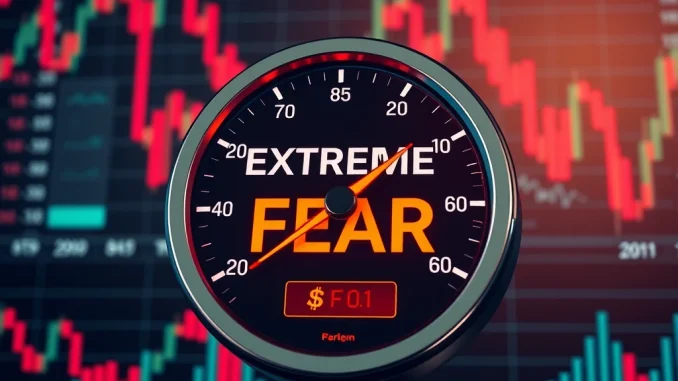
Brace yourselves, crypto enthusiasts! The market sentiment has taken a dramatic turn, and the Crypto Fear & Greed Index is flashing red. Just when we thought we were navigating through ‘Fear’, the index has plunged a staggering 19 points, landing firmly in ‘Extreme Fear’ territory at a chilling 25. What does this mean for your crypto portfolio and the future of Bitcoin? Let’s dive deep into this concerning shift and unpack what’s driving this market anxiety.
Decoding the Crypto Fear & Greed Index: What is ‘Extreme Fear’ Telling Us?
The Crypto Fear & Greed Index, a vital tool provided by Alternative.me, isn’t just a number; it’s a barometer of market emotions. Ranging from 0 (Extreme Fear) to 100 (Extreme Greed), this index synthesizes various market factors to give us a snapshot of overall crypto sentiment. A reading of 25, categorized as ‘Extreme Fear’, suggests investors are deeply worried, potentially indicating a significant market downturn or correction. But what exactly fuels this fear?
Let’s break down the six key elements that construct this crucial index:
- Volatility (25%): Measures the rapid and unpredictable price swings in the crypto market. High volatility often breeds fear as investors become uncertain about price stability.
- Market Momentum/Volume (25%): Examines the overall buying and selling pressure in the market. Low momentum and volume can signal a lack of confidence and contribute to fear.
- Social Media (15%): Analyzes sentiment across various social media platforms, gauging the overall mood of crypto conversations. Negative social media sentiment can amplify fear.
- Surveys (15%): Collects data from crypto surveys to directly assess investor sentiment. Bearish survey results naturally push the index towards fear.
- Bitcoin Dominance (10%): Tracks Bitcoin’s share of the total crypto market capitalization. A falling Bitcoin dominance can sometimes indicate fear as investors might be moving out of Bitcoin into potentially riskier altcoins or stablecoins.
- Google Trends (10%): Analyzes Google search queries related to Bitcoin and crypto terms. A spike in fear-related search terms can reflect and contribute to overall market fear.
Why the Sudden Plunge into ‘Extreme Fear’ in Crypto Market Sentiment?
The significant 19-point drop in a single day is noteworthy and warrants a closer look. Several factors could be contributing to this rapid shift in crypto market sentiment. While the provided content doesn’t specify the exact reasons for this particular drop to ‘Extreme Fear’, we can consider common market drivers that often trigger such sentiment shifts:
- Broader Economic Uncertainty: Global economic conditions, including inflation, interest rate hikes, and geopolitical tensions, can heavily influence crypto markets. Negative economic news often triggers risk-off behavior, leading to increased fear.
- Regulatory Concerns: Uncertainty or negative news regarding crypto regulations from major economies can spook investors and drive fear. Crackdowns or stricter rules often lead to market downturns.
- Market Corrections and Liquidations: Significant price drops in major cryptocurrencies, particularly Bitcoin, can trigger cascading liquidations and further fuel fear. Sharp corrections are often followed by periods of heightened anxiety.
- Black Swan Events: Unexpected events, like major exchange hacks, project collapses, or negative announcements from influential figures in the crypto space, can instantly trigger panic and extreme fear.
- Profit Taking and Market Cycles: After periods of gains, investors may engage in profit-taking, leading to market corrections. If this selling pressure is strong and rapid, it can quickly push the market into fear.
Navigating Bitcoin Volatility in Times of ‘Extreme Fear’
The Crypto Fear & Greed Index being in ‘Extreme Fear’ doesn’t necessarily spell doom and gloom. In fact, for seasoned investors, periods of extreme fear can present unique opportunities. Here’s how to navigate Bitcoin volatility and potentially capitalize on market fear:
Is ‘Extreme Fear’ a Buying Opportunity?
Historically, periods of ‘Extreme Fear’ have often been followed by market rebounds. When fear is rampant, asset prices can become undervalued due to panic selling. This can be an opportune time for investors with a long-term perspective to buy quality assets like Bitcoin at a discount. The contrarian investment strategy suggests that the best time to buy is when others are fearful.
Strategies to Consider During ‘Extreme Fear’:
- Dollar-Cost Averaging (DCA): Instead of trying to time the market bottom, DCA involves investing a fixed amount of money at regular intervals. This strategy helps to mitigate risk during volatile periods and can average out your entry price over time.
- Due Diligence and Research: ‘Extreme Fear’ can be a good time to reassess your portfolio and research fundamentally strong crypto projects that may be oversold. Focus on projects with solid technology, strong teams, and real-world use cases.
- Risk Management: Ensure your portfolio allocation aligns with your risk tolerance. ‘Extreme Fear’ periods are a reminder to manage risk effectively. Consider reducing exposure if you are uncomfortable with the volatility.
- Stay Informed, but Filter Noise: Keep abreast of market news, but be wary of fear-mongering and excessive negativity. Focus on credible sources and fundamental analysis rather than succumbing to panic.
- Long-Term Perspective: Remember that crypto markets are cyclical. ‘Extreme Fear’ phases are often temporary. Maintaining a long-term investment horizon can help you weather short-term volatility.
Analyzing the Crypto Market: Beyond the Fear & Greed Index
While the Crypto Fear & Greed Index is a valuable tool, it’s crucial to conduct a broader crypto market analysis to get a comprehensive picture. Relying solely on one indicator can be limiting. Consider these additional factors for a well-rounded perspective:
- On-Chain Analysis: Examine on-chain metrics like transaction volume, active addresses, whale activity, and exchange flows. These metrics can provide insights into the underlying health and activity of the Bitcoin and broader crypto network.
- Technical Analysis: Utilize technical indicators, chart patterns, and trend lines to identify potential support and resistance levels, and to gauge market momentum.
- Fundamental Analysis: Assess the fundamental value of cryptocurrencies by analyzing their technology, use cases, adoption rates, partnerships, and team strength.
- News and Events: Stay updated on relevant news, regulatory developments, technological advancements, and macroeconomic events that can impact the crypto market.
- Market Sentiment Across Different Platforms: Beyond the Fear & Greed Index, monitor sentiment on various crypto news outlets, forums, and social media platforms to get a broader understanding of market mood.
Conclusion: Navigating Fear and Finding Opportunity in Crypto
The sudden plunge of the Crypto Fear & Greed Index into ‘Extreme Fear’ is undoubtedly a concerning signal, highlighting heightened anxiety within the crypto market. However, it’s essential to remember that fear is a natural part of market cycles, and periods of extreme fear can often pave the way for future growth. By understanding the factors driving this sentiment, employing sound risk management strategies, and conducting thorough market analysis, investors can navigate these turbulent times and potentially uncover valuable opportunities amidst the fear. Stay informed, stay rational, and remember that in the world of crypto, volatility and opportunity often go hand in hand.



